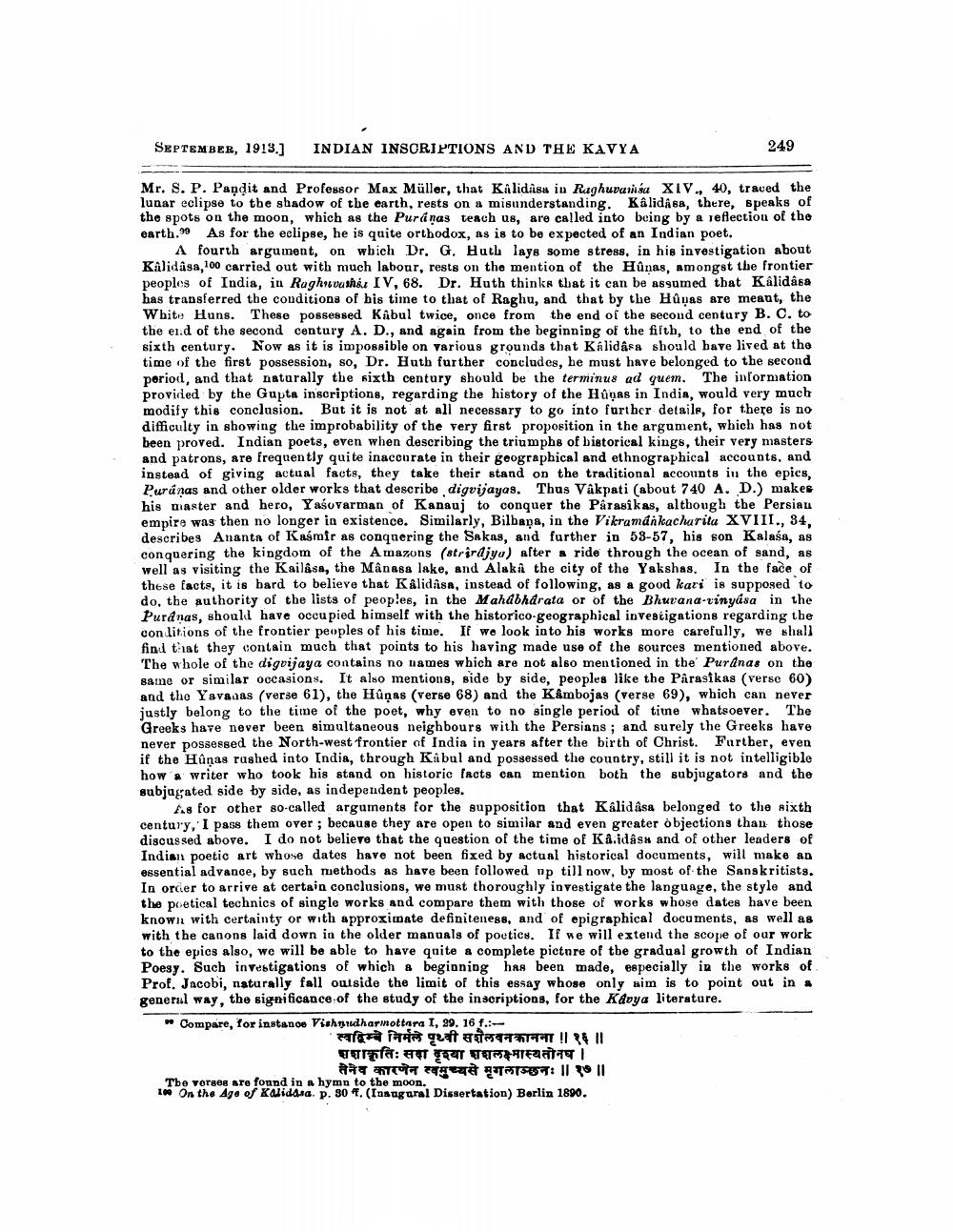________________
SEPTEMBER, 1913.]
Mr. S. P. Pandit and Professor Max Müller, that Kalidasa in Raghuvansa XIV., 40, traced the lunar eclipse to the shadow of the earth, rests on a misunderstanding. Kâlidâsa, there, speaks of the spots on the moon, which as the Puranas teach us, are called into being by a reflection of the earth.99 As for the eclipse, he is quite orthodox, as is to be expected of an Indian poet.
INDIAN INSCRIPTIONS AND THE KAVYA
A fourth argument, on which Dr. G. Huth lays some stress, in his investigation about Kalidasa,100 carried out with much labour, rests on the mention of the Hûnas, amongst the frontier peoples of India, in Raghuvatház IV, 68. Dr. Huth thinks that it can be assumed that Kâlidâsa has transferred the conditions of his time to that of Raghu, and that by the Hûuas are meant, the White Huns. These possessed Kabul twice, once from the end of the second century B. C. to the end of the second century A. D., and again from the beginning of the fifth, to the end of the sixth century. Now as it is impossible on various grounds that Kalidasa should have lived at the time of the first possession, so, Dr. Huth further concludes, he must have belonged to the second period, and that naturally the sixth century should be the terminus ad quem. The information provided by the Gupta inscriptions, regarding the history of the Hûpas in India, would very much modify this conclusion. But it is not at all necessary to go into further details, for there is no difficulty in showing the improbability of the very first proposition in the argument, which has not been proved. Indian poets, even when describing the triumphs of historical kings, their very masters and patrons, are frequently quite inaccurate in their geographical and ethnographical accounts, and instead of giving actual facts, they take their stand on the traditional accounts in the epics, Puranas and other older works that describe digvijayas. Thus Vâkpati (about 740 A. D.) makes his master and hero, Yasovarman of Kanauj to conquer the Pârasikas, although the Persian empire was then no longer in existence. Similarly, Bilbapa, in the Vikramánkacharita XVIII., 34, describes Ananta of Kasmir as conquering the Sakas, and further in 58-57, his son Kalasa, as conquering the kingdom of the Amazons (strirajya) after a ride through the ocean of sand, as well as visiting the Kailasa, the Mânasa lake, and Alaka the city of the Yakshas. In the face of these facts, it is hard to believe that Kâlidâsa, instead of following, as a good kari is supposed to do, the authority of the lists of peoples, in the Mahabharata or of the Bhuvana-vinyasa in the Puranas, should have occupied himself with the historico-geographical investigations regarding the conditions of the frontier peoples of his time. If we look into his works more carefully, we shall find that they contain much that points to his having made use of the sources mentioned above. The whole of the digvijaya contains no names which are not also mentioned in the Puranas on the same or similar occasions. It also mentions, side by side, peoples like the Pârasikas (verse 60) and the Yavanas (verse 61), the Hûnas (verse 68) and the Kambojas (verse 69), which can never justly belong to the time of the poet, why even to no single period of time whatsoever. The Greeks have never been simultaneous neighbours with the Persians; and surely the Greeks have never possessed the North-west frontier of India in years after the birth of Christ. Further, even if the Hûnas rushed into India, through Kâbul and possessed the country, still it is not intelligible how a writer who took his stand on historic facts can mention both the subjugators and the subjugated side by side, as independent peoples.
249
As for other so-called arguments for the supposition that Kâlidâsa belonged to the sixth century, I pass them over; because they are open to similar and even greater objections than those discussed above. I do not believe that the question of the time of Kâ.idâsa and of other leaders of Indian poetic art whose dates have not been fixed by actual historical documents, will make an essential advance, by such methods as have been followed up till now, by most of the Sanskritists. In order to arrive at certain conclusions, we must thoroughly investigate the language, the style and the poetical technics of single works and compare them with those of works whose dates have been known with certainty or with approximate definiteness, and of epigraphical documents, as well as with the canons laid down in the older manuals of poetics. If we will extend the scope of our work to the epics also, we will be able to have quite a complete picture of the gradual growth of Indian Poesy. Such investigations of which a beginning has been made, especially in the works of Prof. Jacobi, naturally fall outside the limit of this essay whose only aim is to point out in a general way, the significance of the study of the inscriptions, for the Kavya literature.
"Compare, for instance Vishnudharmottara I, 29. 16 f.:
'स्वद्विम्बे निर्मले पृथ्वी सशैलवनकानना ॥ १६ ॥ शशाकृतिः सदा दृश्या शशलक्ष्मास्यतोनघ ।
तेनैव कारणेन स्वमुच्यसे मृगलाञ्छनः ॥ १७ ॥
The verses are found in a hymn to the moon. 100 On the Age of Kalidasa. p. 30 f. (Inaugural Dissertation) Berlin 1890.




